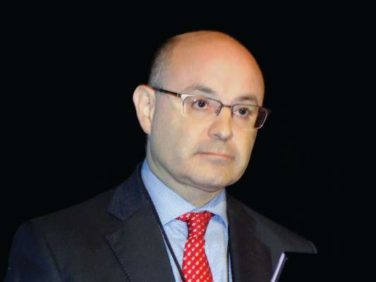AT THE INTERNATIONAL LIVER CONGRESS 2015
VIENNA (FRONTLINE MEDICAL NEWS) – Nonalcoholic fatty liver disease often goes overlooked as a cause of liver cancer despite its increasing role as a major driver of hepatocellular carcinoma.
During 2004-2009, nonalcoholic fatty liver disease (NAFLD) appeared to be the primary cause for 26% of the hepatocellular carcinoma (HCC) diagnosed among U.S. patients, according to data collected by the National Cancer Institute, Dr. Zobair M. Younossi reported at the meeting sponsored by the European Association for the Study of the Liver.
That placed NAFLD second only to infection by hepatitis C virus, which linked with 48% of HCC cases. Third and fourth places went to alcoholic liver disease, causing 14% of cases, and hepatitis B virus infection, the trigger for 8% of HCC cases.
“There is a huge gap in understanding and recognition of NAFLD, and especially progressive fatty-liver disease – nonalcoholic steatohepatitis (NASH), as important diseases and that some of these patients will develop cirrhosis and HCC,” Dr. Younossi said in an interview. The aggressiveness with which physicians follow NAFLD and specifically NASH patients for development of HCC “is not as well implemented as it is for patients with viral hepatitis,” said Dr. Younossi, head of the Center for Liver Diseases at Inova Fairfax Hospital in Falls Church, Va.
Patients with NASH “don’t get screened enough, and, when they are screened, the strategy is not done well” as it usually relies on ultrasound, which is problematic in obese patients. Obesity is a common comorbidity in patients with NAFLD or NASH, he said. Dr. Younossi highlighted a recommendation made last year by the American Association for the Study of Liver Diseases that suggested consideration of regular HCC screening in patients with NASH and cirrhosis ( Hepatology 2012:55:2005-23 ). He recommended routine screening particularly for NAFLD patients who have developed NASH and also cirrhosis or advanced liver fibrosis, a complication that can be estimated without a liver biopsy by way of the NAFLD fibrosis score calculator .
Another striking finding of the new analysis was that HCC associated with NAFLD was deadlier than were cases linked with other causes, with a 21% relative increase in 1-year mortality following initial HCC diagnosis compared with liver cancers caused by viral hepatitis or alcohol use. “Patients with HCC and NAFLD have a worse prognosis than any other type of HCC,” Dr. Younossi said.
The analysis used linked data from the Surveillance Epidemiology and End Results ( SEER ) program run by the National Cancer Institute, and the Centers for Medicare & Medicaid Services, and included 5,748 HCC cases and 17,244 matched control individuals without HCC. The SEER data showed that total U.S. HCC cases rose by roughly a third during the period 2004-2009, Dr. Younossi reported .
Patients with HCC linked with NAFLD were significantly older than were other HCC patients, at an average age of 72 years for the NAFLD group compared with 66 years for everyone else, and mortality came an average of 4 months faster in the NAFLD subgroup. By 1 year after HCC diagnosis, mortality was 62% among the NAFLD patients and 50% among everyone else.
Although results from prior reports had linked HCC and NAFLD, the new findings “strengthen the evidence” using a population-based registry, Dr. Younossi said. The new results also show for the first time the increased first-year mortality from HCC in NAFLD patients. He speculated that the frequent coexistence of diabetes in NAFLD patients might contribute to the more aggressive course, as well as later diagnosis because of unsuspected disease and also the challenge of using ultrasound to screen obese patients. Dr. Younossi recommended using CT imaging as an alternative for noninvasively finding potential cases of HCC.
On Twitter @mitchelzoler



